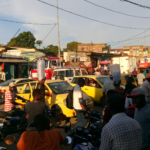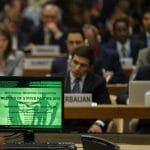Science, technology, and the bioweapons treaty
By Malcolm Dando | May 13, 2011
If one listened closely to the discussions around the recent meeting of the Preparatory Committee for the upcoming review of the Biological Weapons Convention (BWC), one might have heard a distant rumble of concern. These worries stem from the widespread recognition that advances in the life sciences are progressing at a rate faster than the treaty seems able to keep pace with.
Yet the treaty is actually equipped to cope with problems like this. The BWC’s Article XII mandates that every five years a review conference will be held for state parties to assess the treaty’s operation “with a view to assuring that the purposes of the preamble and the provisions of the Convention … are being realized.” The Seventh BWC Review Conference will take place in Geneva this December. Significantly for the scientific community, Article XII concludes by specifying that the “review shall take into account any new scientific and technological developments relevant to the Convention” (emphasis mine). The distant rumblings reflect concern that the BWC is nevertheless not doing enough to “take into account” and keep abreast of such developments.
The response of BWC state parties to the last provision of Article XII has been increasingly seen as inadequate. At past review conferences, state parties that so desire have contributed to background papers on treaty-relevant developments in science and technology (S&T). Unfortunately, these papers appear to receive little consideration in the rushed proceedings of the review conferences. As concerns about the scope and pace of advances in biology have been increasingly recognized, evaluating whether the treaty’s system of S&T review is adequate becomes more and more important.
Indeed, UN Secretary-General Ban Ki-moon remarked last year that “With the pace of advances in biological science and technology growing ever quicker, there is a pressing need for a structured and regular means of monitoring developments and assessing their implications.” The upcoming review conference, he said, “offers the best chance in a decade or more to reach significant agreements on the future of the Convention.”
Thus it is not surprising that at the latest Preparatory Committee meeting one of the main topics of interest to civil society was how to use the review conference to construct a better mechanism for assessing the impact of scientific advances on all of the articles of the BWC. At least three seminars for BWC delegates, hosted by nongovernmental organizations, directly addressed S&T advances and how the treaty should deal with them.
An effective assessment of the impact of these advances is important because S&T developments may well affect key articles of the BWC. For example, given progress in genomics, nanotechnology, proteomics, and other areas, is Article I still broad enough to cover the total prohibition of the misuse of the life sciences? Could systems of export control, covered in Article III, be bypassed or circumvented by advances in synthetic biology? Do S&T advances present new opportunities for increased international peaceful cooperation, as outlined in Article X? State parties need urgently to discuss and agree on the answers to these questions.
As pointed out in a seminar by the Harvard Sussex Program (HSP), concern about whether the BWC is adequately keeping pace with scientific progress is nothing new: “calls to do ‘something’ about how S&T of relevance to the BWC is reviewed have a long history stretching back to at least 1979.” I think the time has finally come for the BWC to improve the way in which scientific and technological advances are monitored and assessed in order to be “responsive to tomorrow’s challenges, not yesterday’s,” as Barry Kellman, director of the International Weapons Control Center, has put it.
There are many different models of how S&T assessments are made and used in related international agreements. The key question is: What will best fit the BWC? For example, instead of state parties contributing to background papers as they randomly see fit, the handling of S&T reviews might be done through a yearly meeting of governmental and nongovernmental experts who report on specific topics in a special “S&T issues” section of a restructured annual meeting of state parties.
In recent years, the BWC’s annual meetings of experts have done a nice job of discussing S&T issues, especially as these meetings have evolved to incorporate more ideas and individuals from civil society — scientists from academia, industry, and professional associations, for example. Developing this system seems to me to be a logical next step forward, but first and foremost we need to get beyond general discussions and on to dealing with the specific implications of S&T developments on the treaty. Allaying reasonable worries about the BWC’s ability to keep up with scientific progress is a challenge that state parties must embrace at the upcoming review conference.
(Editor’s note: The Bulletin’s May/June digital journal is a special issue on the Biological Weapons Convention Review Conference.)
Together, we make the world safer.
The Bulletin elevates expert voices above the noise. But as an independent nonprofit organization, our operations depend on the support of readers like you. Help us continue to deliver quality journalism that holds leaders accountable. Your support of our work at any level is important. In return, we promise our coverage will be understandable, influential, vigilant, solution-oriented, and fair-minded. Together we can make a difference.
Topics: Biosecurity, Columnists















